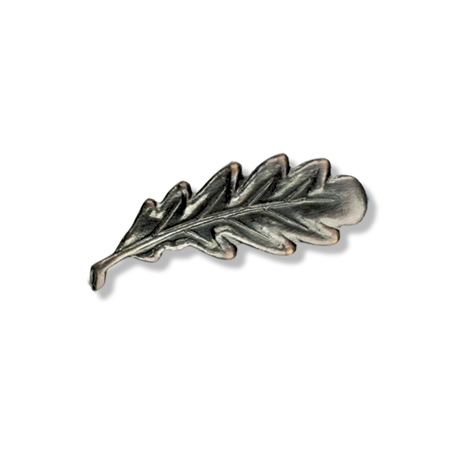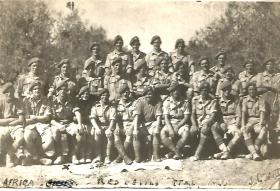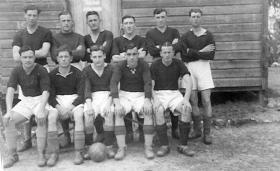James Rodney Greenhalgh was born in Salford (then Lancashire) in 1920. He attended St.Thomas of Cantabury school in Higher Broughton, Salford and left school in 1934. He was a talented footballer and was an apprentice plumber amongst other jobs. Ron joined the TA in July 1939 joining the 2/8th Manchesters at Ardwick. The Battalion was mobilised upon the outbreak of war and were intially tasked with defending Ringway airfield (later to become home to the central landing establishment and No 1 PTS). Ron was quickly promoted to Corporal and played midfield for the battalion team as well representing the battalion at boxing.
Promoted to sergeant, the battalion moved south to Hastings in Kent where Ron witnessed the battle of britain in the skys above. The CO of the Manchester's interviewed Ron and asked if he would consider taking a commission? Ron agreed and found himself heading North again to 163 OTCU at the old hall, Heysham close to the banks of the river Lune. After months of training, Ron was commissioned into the Manchester's but ended up at the Green Howard's depot in Richmond, Yorkshire.
Like many of his generation, Ron was frustrated and wanted 'to get amongst it' with the enemy. He volunteered for Airborne Forces and was interviewed by the CO of the 4th Parachute Battalion, Lt Col Dene.
Ron attended Hardwick hall and despite been very fit found his feet didn't touch the floor. Route marches, assault course and gym work were the relentless routine. He was pleased to pass and progressed back to Manchester and Ringway for parachute training. On Ron's first decent from a balooon at Tatton Park he wondered as the cage rose if he was up to it? He was. Apart from 'ringing the bell' whilst on an aircraft decent he sucessfully passed and qualified as a parachutist.
Ron joined 4th Parachute Battalion at Bulford mid 1942 commanding 11 platoon in C Company. Moving with the battalion to North Africa, days were filled with route marches, filed firing and learning to parachute with the newly issued leg bag.
Ready to join the rest of the division, 4 PARA was stood down prior to take off for Scilly. They would not have to wait too long to get a crack at the enemy as they were soon to sail to Taranto in southern Italy.
Ron's first action was at CASOLI. Entry from 4th Battalion War Diary
10/12/43 in the Sangro river area.
CASOLI. 0100. GREENHALGH (Comd 11 Pln C Company) returned. Enemy found in strength (about 40 with MP's and at least 4 MGS) on LA MORGIA. LA MORGIA is a steep feature with a 6ft bank in front of enemy position. Platoon attacked up slope at about 21:00hrs, patrol was forced to withdraw as it was almost impossible to get up the bank and get at the enemy. 7 of own men wounded and missing and number of enemy seen to be hit by own LMG fire.
From this patrol report, the four KIA on the patrol are believed to be:
Cpl Gardhouse, Cpl Sims, Cpl Hodge, Pte Craig
Ron Greenhalgh, 11 Platoon, C Company spent 6 hard months fighting the Germans, including time spent at Monte Cassino.
A short but vital Airborne Operation (OP Dragoon) took place in August 1944 when 2nd Independant Parachute Brigade (left behind to fight it out in Italy after the rest of 1st Airborne Division was withdrawn to to the UK in December 1943). Returning to Italy, they were soon warned off to deploy to Greece to ensure the withdrawl of the Germans and avoid the Communist take over.
Ron was one of the fortunate one's on the infamous parachute assault onto Megra airfield. He was scratched and a little dazed but otherwise in good shape. On the night of 26th-27th October, C Company under OC Maj Gourlay MC, assaulted a hill in a town called KOZANI (close to the Macedonia border). This was a deliberate attack up hill which was occupied by several hundred Germans and Greek security irregulars. Ron's 11 Platoon were forced to make a left flanking move in order to remain in position. The attack was successful but came at a price. 2 Officers (Capt Teede and Lt Phillips were killed) as well as 5 other ranks (L/Cpl Bowker, Ptes Bowser, Creswell, Mann, Oatt). One officer was injured (Ron) and 13 other ranks.
Ron was evacuated on a donkey off the mountain. Ron was casevaced to Italy to recouperate and caught up with battalion again later in Athens where he was tasked to run the R&R cell. A welcome job after six months in Italy, then the South of France and then Kozani.
Post war. Ron returned to Manchester. He joined 13th Battalion the Parachute Regiment which had re formed as a TA battalion in the North West of England. Ron was a Lt in 13 PARA based at Heaton Park and Seymor Grove (Whalley Range).
He trained as a teacher, and had to give up the TA as he did not have time to do both.
Ron married and brought up his family in South Manchester, not 5 miles from Ringway airport. Ron was a devoted father, teacher and had a full career teaching at the the same school until he retired in 1982. He returned to the same school as a volunteer (unpaid) to help children with reading and writing.
When Ron was interviewed about his war service in 2006, he was asked what he had learnt about leadership and his men. He stated they were 'Confident, well disciplined, performed well and could be trusted'.
When asked what he thought about what he had done over sixty years ago he replied "Proud. I was very lucky to have had the experiences I had and survived and to have met and worked with such a splendid bunch of men who were great human beings, warts and all"!
Ron Greenhalgh passed away in October 2008








Latest Comments
There are currently no comments for this content.
Add Comment
In order to add comments you must be registered with ParaData.
If you are currently a ParaData member please login.
If you are not currently a ParaData member but wish to get involved please register.